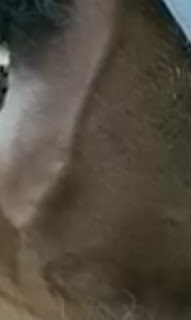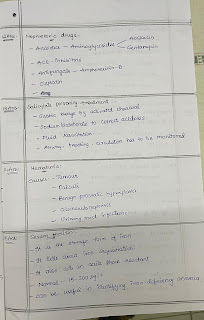1801006120-Short case
This is an a online e log book to discuss our patient de-identified health data shared after taking his / her / guardians signed informed consent. Here we discuss our individual patients problems through series of inputs from available global online community of experts with an aim to solve those patients clinical problem with collective current best evident based input.
This E blog also reflects my patient centered online learning portfolio and your valuable inputs on the comment box is welcome.
I have been given this case to solve in an attempt to understand the topic of " patient clinical data analysis" to develop my competency in reading and comprehending clinical data including history, clinical findings, investigations and come up with diagnosis and treatment plan.This is an a online e log book to discuss our patient de-identified health data shared after taking his / her / guardians signed informed consent. Here we discuss our individual patients problems through series of inputs from available global online community of experts with an aim to solve those patients clinical problem with collective current best evident based input.
Chief complaints:-
A 42 year old male patient was brought to casuality with chief complaints of both lower limb swelling since 15 days and SOB since 2 days.
History of presenting illness:-
Patient was apparently asymptomatic 15
days back & then he noticed bilateral
lower limb swelling which was insidious in
onset gradually progressing pitting type extending up to the knees.
Patient also complaining of breathlessness
since 2 days which is Grade 2 initially
progressed to Grade 3-4 associated with
orthopnea & paroxysmal nocturnal dyspnoea
No h/o cough, chest pain
No h/o pain abdomen, vomiting, loose stools
No h/o decreased urine output/ burning micturition.
No h/o pain abdomen, vomiting, loose stools
No h/o decreased urine output/ burning micturition.
No h/o palpitations
No h/o wheeze and hemoptysis
No history of abdominal distension
Past history:-
Personal history:-
Diet – Mixed
Appetite – Decreased
Sleep – adequate
Bladder & Bowel movements –
Regular
He has been consuming alcohol 180ml daily , Chronic smoker 2 pack beedi/day.
He had history of fever, decreased appetite, cough for which he went to a local hospital where he was diagnosed with Tuberculosis and took medicines irregularly
He was not known case of hypertension,epilepsy,asthma
He was not known case of hypertension,epilepsy,asthma
Personal history:-
Diet – Mixed
Appetite – Decreased
Sleep – adequate
Bladder & Bowel movements –
Regular
He has been consuming alcohol 180ml daily , Chronic smoker 2 pack beedi/day.
Family history:-no relevant family history
Treatment history:-
He was on anti tubercular therapy which he used irregularly
Palpation:-
General examination:-
Patient is conscious,coherent,cooperative
thin built & nourished
Pedal edema is present
No pallor, Icterus,cyanosis, clubbing, lymphadenopathy
Patient is conscious,coherent,cooperative
thin built & nourished
Pedal edema is present
No pallor, Icterus,cyanosis, clubbing, lymphadenopathy
Vitals:-
1.Temperature:- 98.6 F
2.Pulse rate: 110 beats per min , regular
3.Respiratory rate: 18 cycles per min
4.BP: 100/70 mm Hg
1.Temperature:- 98.6 F
2.Pulse rate: 110 beats per min , regular
3.Respiratory rate: 18 cycles per min
4.BP: 100/70 mm Hg
Systemic examination:-
Cvs examination:-
Inspection:-
Chest is barrel shaped, bilaterally
symmetrical.
Trachea is central
Trachea is central
Movements are equal bilaterally
JJvp-raised
No scars or sinuses
Apical impulse seen in left 6th
intercostal space lateral to mid
clavicular line
Apical impulse seen in left 6th
intercostal space lateral to mid
clavicular line
PALPATION:-
All inspectory findings are confirmed:
Trachea is central, movements equal bilaterally.
Antero-posterior diameter of chest >Transverse
diameter of chest
Apex beat felt in left 6th intercostal space lateral
to midclavicular line
Trachea is central, movements equal bilaterally.
Antero-posterior diameter of chest >Transverse
diameter of chest
Apex beat felt in left 6th intercostal space lateral
to midclavicular line
Auscultation:-
S1 S2 heard
No murmurs
No murmurs
RRespiratory system:-
Inspection:-Chest is barrel shaped, bilaterally symmetrical.
Trachea is central
Movements are equal bilaterally
Visible epigastric pulsations
No scars or sinuses
Apical impulse seen in left 6th ICS lateral to MCL
Trachea is central
Movements are equal bilaterally
Visible epigastric pulsations
No scars or sinuses
Apical impulse seen in left 6th ICS lateral to MCL
All inspectory findings are
confirmed:
Trachea is central, movements
equal
bilaterally.
Antero-posterior diameter of
chest
>Transverse diameter of chest
Apex beat felt in 6th intercostal
space lateral to midclavicular line
Vocal fremitus decreased in
right infraaxillary and
infrascapular area.
Percussion
Dull note heard in right
infraaxillary & infrascapular area
Resonant note heard in all other
areas bilaterally
Auscultation:-
Bilateral air entry present –
Normal vesicular breath sounds
heard
Breath sounds decreased in right
infraaxillary and infrascapular
Vocal resonance decreased in
right infraaxillary& infrascapular
area
Expiratory wheeze heard
bilaterally
Per abdomen:-
Scaphoid
Visible epigastric pulsations
No engorged
veins/scars/sinuses
Soft , non tender
No organomegaly
Tympanic node heard all over
the abdomen
Bowel sounds present
Central nervous system:-
Higher motor functions-intact
Speech – Normal
No Signs of Meningeal
irritation
Motor and sensory system –
Normal
Reflexes – Normal
Cranial Nerves – Intact
Gait – Normal
Cerebellum – Normal
Provisional diagnosis:-Heart
failure;Right sided pleural
effusion;chronic obstructive
pulmonary disease.
Serum creatinine:-
1.1 mg/dl ( normal
0.9-1.3)
Blood urea - 81 mg/dl
Hemoglobin - 11.3
mg/dl
Chest Xray
Ultrasound findings -
Right sided pleural effusion
with mild ascites
2D echo:-
Final diagnosis:-
Heart failure
B/l PLEURAL
EFFUSION (R > L)
Copd
Treatment :
-Fluid
restriction<1lit/day
-Salt restriction
<2gm/day
-Tab.Lasix 40mg twice
daily
-Tab.Met-xl 25mg Bd
-Blood pressure,pulse
rate,temperature and spo2
monitoring








Comments
Post a Comment